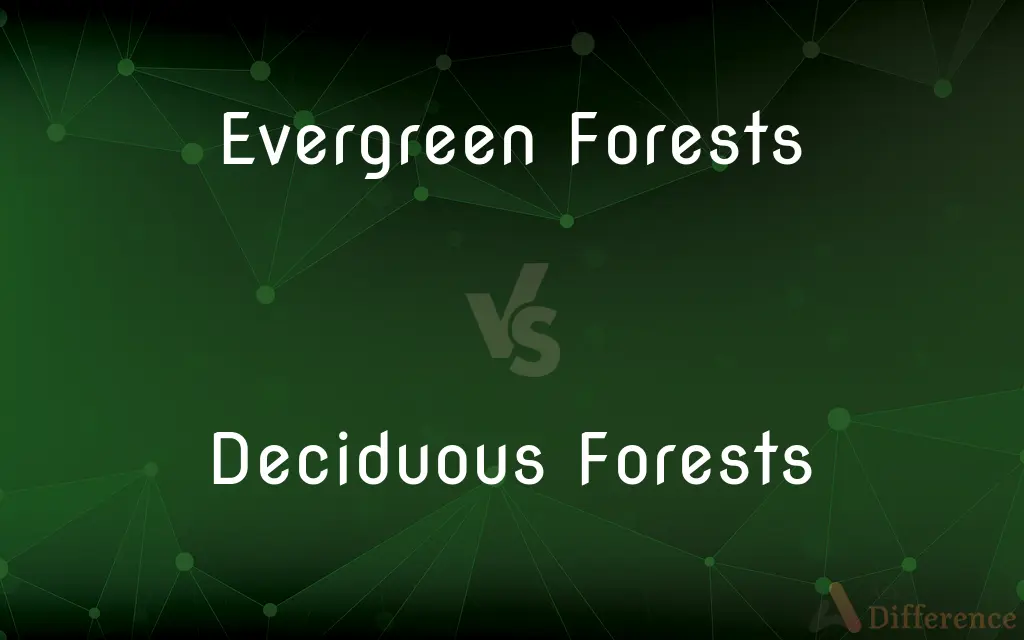Evergreen Forests vs. Deciduous Forests — What's the Difference?
Edited by Tayyaba Rehman — By Fiza Rafique — Published on January 2, 2024
Evergreen forests retain foliage year-round, while deciduous forests shed leaves annually.

Difference Between Evergreen Forests and Deciduous Forests
Table of Contents
ADVERTISEMENT
Key Differences
Evergreen forests are characterized by trees that maintain their leaves throughout the year. These forests can be found in both cold and warm climates, from the coniferous forests of the taiga to the tropical rainforests near the equator. Evergreens have a continuous canopy, providing uninterrupted shade and habitat for wildlife.
Deciduous forests consist of trees that lose their leaves each year, typically in response to colder temperatures. Found in temperate zones, deciduous trees like oaks and maples have a yearly cycle of shedding leaves, leading to a dramatic change in landscape appearance with the seasons. This leaf loss is an adaptation to conserve water and energy during less favorable conditions.
The climate in evergreen forests is relatively stable, providing a consistent environment that supports diverse ecosystems. Because evergreen trees don't lose their leaves en masse, they are better at protecting soil from erosion and maintaining soil moisture throughout the year, which affects the forest undergrowth and overall biodiversity.
In contrast, deciduous forests experience more seasonal changes. The fall of leaves creates a thick layer of detritus on the forest floor, which decomposes and enriches the soil. This seasonal litter fall promotes a cycle of renewal that impacts soil fertility, insect populations, and undergrowth patterns in these forests.
Lastly, evergreen forests tend to have trees with needles or thick, waxy leaves to minimize water loss, while deciduous forests have broad-leaved trees that can maximize sunlight absorption during the growing season. The differences in leaf structures are adaptations to the environmental challenges each type of forest faces.
ADVERTISEMENT
Comparison Chart
Leaf Retention
Retain leaves year-round.
Shed leaves annually.
Climate
Found in varied climates, stable environment.
Typically in temperate zones, seasonal changes.
Biodiversity
Consistent habitat supporting diverse life.
Seasonal changes affect species diversity.
Soil Conservation
Protects soil from erosion continuously.
Leaf litter decomposes to enrich soil.
Leaf Type
Needles or waxy leaves to reduce water loss.
Broad leaves for optimal sunlight absorption.
Compare with Definitions
Evergreen Forests
Many evergreen forest trees have needles for leaves.
Pine trees add to the evergreen forests' year-round greenery.
Deciduous Forests
Fallen leaves in deciduous forests enrich the soil.
The decomposing leaves from deciduous forests create fertile ground.
Evergreen Forests
Evergreen forests support a wide range of wildlife.
Evergreen forests are home to an array of bird species.
Deciduous Forests
Trees in deciduous forests usually have wide, flat leaves.
Broadleaf trees are characteristic of deciduous forests.
Evergreen Forests
Evergreen forests thrive in both cold and tropical climates.
Evergreen forests cover the mountain slopes and the equatorial belt.
Deciduous Forests
Deciduous forest trees shed leaves to conserve water and energy.
The forest floor is blanketed with leaves from deciduous forests.
Evergreen Forests
Trees in evergreen forests keep their leaves all year.
The evergreen forests are lush even in the coldest winters.
Deciduous Forests
Trees in deciduous forests lose their leaves seasonally.
Deciduous forests turn into vibrant hues of orange and red in the fall.
Evergreen Forests
The canopy in evergreen forests rarely thins.
The dense canopy of evergreen forests provides ample shade.
Deciduous Forests
Deciduous forests are prominent in areas with distinct seasons.
Deciduous forests dominate the temperate regions of the world.
Common Curiosities
What defines an evergreen forest?
An evergreen forest is defined by its trees that keep their leaves throughout the year.
What defines a deciduous forest?
A deciduous forest is defined by its trees that lose all their leaves during one season annually.
Where are evergreen forests commonly found?
Evergreen forests are commonly found in both cold regions like the taiga and tropical climates.
How do deciduous forests affect biodiversity?
Deciduous forests support biodiversity with seasonal changes that create dynamic habitats for different species.
Where are deciduous forests commonly found?
Deciduous forests are commonly found in temperate regions with four distinct seasons.
Are evergreen forests important for the environment?
Yes, evergreen forests are important for carbon sequestration and preventing soil erosion.
Why do deciduous forests shed their leaves?
Deciduous forests shed their leaves as an adaptation to save water and survive cold or dry seasons.
How do evergreen forests affect biodiversity?
Evergreen forests provide a stable habitat that supports diverse flora and fauna throughout the year.
Why don't evergreen forests lose their leaves?
Evergreen forests don't lose their leaves to ensure year-round photosynthesis and protection for wildlife.
Can evergreen forests withstand cold temperatures?
Many evergreen forests, especially coniferous ones, are adapted to survive in very cold temperatures.
What types of animals live in deciduous forests?
Deciduous forests are home to a variety of animals, including birds, bears, and small mammals.
Do evergreen forests change colors with seasons?
No, evergreen forests typically remain green throughout the year.
Are deciduous forests important for the environment?
Yes, deciduous forests contribute to the carbon cycle and provide habitats for a variety of species.
How do deciduous trees prepare for winter?
Deciduous trees prepare for winter by slowing down water intake and shedding their leaves to conserve resources.
What types of animals live in evergreen forests?
Animals like deer, wolves, and various bird species live in evergreen forests.
Do deciduous forests change colors with seasons?
Yes, deciduous forests change colors, especially in autumn when leaves turn yellow, orange, and red before falling.
Share Your Discovery

Previous Comparison
Independence Day of India vs. Republic Day of IndiaAuthor Spotlight
Written by
Fiza RafiqueFiza Rafique is a skilled content writer at AskDifference.com, where she meticulously refines and enhances written pieces. Drawing from her vast editorial expertise, Fiza ensures clarity, accuracy, and precision in every article. Passionate about language, she continually seeks to elevate the quality of content for readers worldwide.
Edited by
Tayyaba RehmanTayyaba Rehman is a distinguished writer, currently serving as a primary contributor to askdifference.com. As a researcher in semantics and etymology, Tayyaba's passion for the complexity of languages and their distinctions has found a perfect home on the platform. Tayyaba delves into the intricacies of language, distinguishing between commonly confused words and phrases, thereby providing clarity for readers worldwide.















































